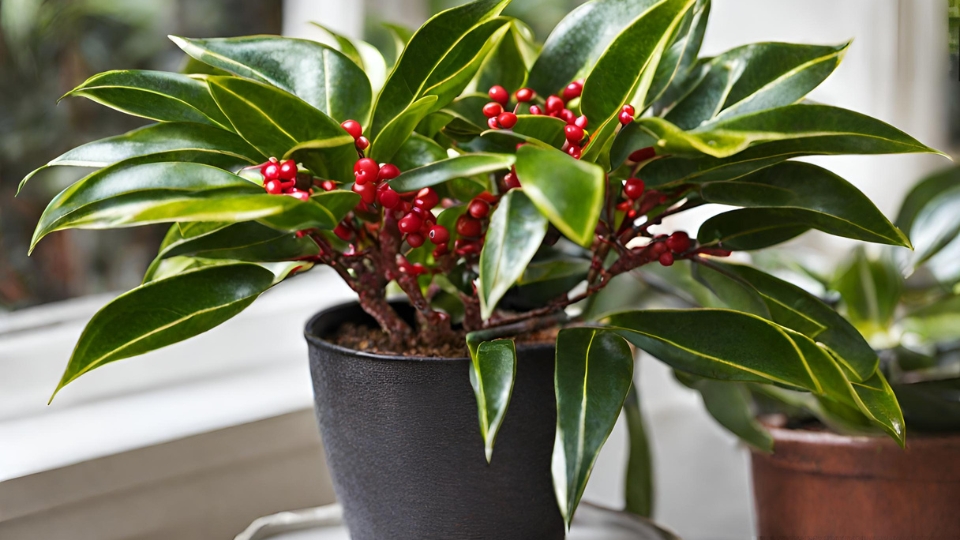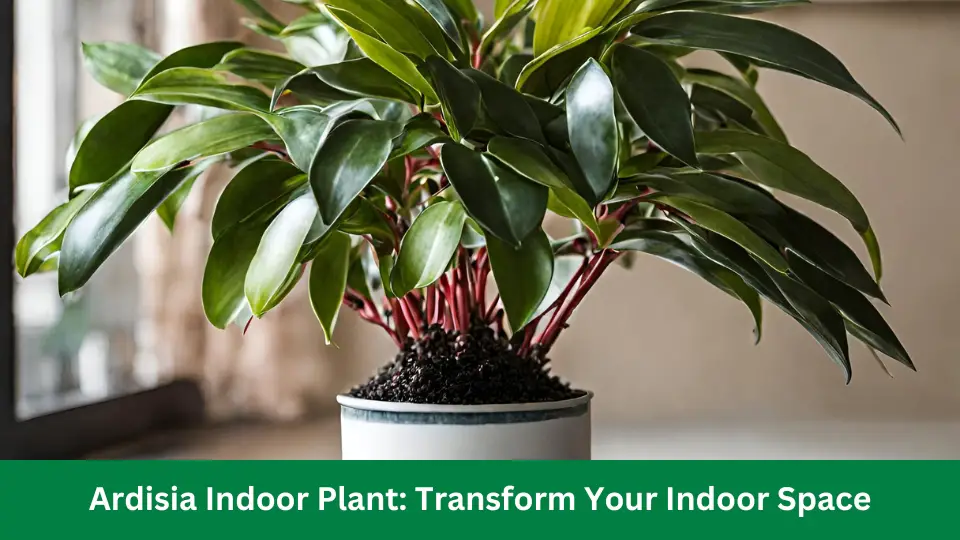The Ardisia indoor plant is popular for its glossy green leaves and bright red berries. It is easy to care for and adds color to any indoor space.
When selecting an Ardisia plant, look for healthy, vibrant foliage and avoid signs of pests or disease. Ensure the plant receives indirect sunlight and consistent watering to thrive. With proper care, the Ardisia indoor plant can be a beautiful and low-maintenance addition to your home.
Whether you are a beginner or an experienced plant lover, Ardisia will surely bring joy and beauty to your indoor environment.
Understanding Ardisia As An Indoor Plant
The Ardisia plant, known for its glossy, dark green leaves and clusters of vibrant berries, is a popular choice for indoor plant enthusiasts. Understanding Ardisia as an indoor plant entails recognizing its unique characteristics and the benefits it offers when grown in indoor environments.

Ardisia Characteristics
- Ardisia features glossy, leathery leaves that add a touch of elegance to any indoor space.
- This plant is relatively low-maintenance, making it an ideal choice for those new to indoor gardening.
- Ardisia typically thrives in indirect light and prefers moderate humidity levels.
- It is a slow-growing plant, often staying compact, making it suitable for smaller living spaces.
- The plant’s vibrant berries add color, creating an eye-catching display.
Benefits Of Ardisia Indoors
- Improved Air Quality: Ardisia plants help purify the air by removing toxins and releasing oxygen, creating a healthier indoor environment.
- Enhanced Aesthetics: Ardisia’s glossy leaves and colorful berries add visual appeal to indoor settings, elevating the overall decor.
- Low Maintenance: Ardisia’s ability to thrive in low-light and moderate humidity conditions makes it a hassle-free indoor plant option.
- Space-Saving: Its slow growth and compact size make Ardisia suitable for smaller living spaces and office environments.
- Potential Health Benefits: Some indoor gardeners believe having Ardisia in their environment may contribute to their overall well-being and mental health.
Getting Started: Choosing And Caring For Ardisia
The Ardisia plant is excellent for adding lush greenery to your indoor space. Not only does it contribute to your home’s aesthetics, but it also offers health benefits. These include purifying the air and promoting calm and well-being.
However, it is essential to select the right variety of Ardisia and provide proper care and maintenance to ensure its health and vitality.

Selecting The Right Ardisia Variety
When choosing an Ardisia plant for your indoor space, choosing the variety that best suits your environment and preferences is important. Some popular Ardisia varieties include the Ardisia crenata, the Coralberry, the Ardisia plant, or the Shoebutton Ardisia.
The Coralberry is characterized by its glossy green leaves and bright red berries. In contrast, the Shoebutton Ardisia features elongated, pointed leaves and clusters of small white flowers. Consider each variety’s size, growth habits, and maintenance requirements to determine the ideal indoor setting.
Proper Care And Maintenance
Once you’ve selected the right Ardisia variety, proper care and maintenance are crucial for its overall well-being. Here are a few key considerations to keep in mind:
- Light: Ardisia plants thrive in bright, indirect light. Place your plant near a window where it can receive adequate sunlight without exposure to direct rays that can scorch its leaves.
- Watering: Keep the soil consistently moist but not waterlogged. Water your Ardisia plant regularly, allowing the top inch of soil to dry out between waterings. Avoid overwatering, as this can lead to root rot.
- Humidity: Ardisia plants prefer moderate to high humidity levels. Consider using a pebble tray filled with water or a room humidifier to create a humid environment.
- Temperature: Maintain a stable indoor temperature between 65-75°F (18-24°C) for optimal growth. Keep the plant away from drafty areas and sudden temperature fluctuations.
- Fertilization: Feed your Ardisia plant with a balanced liquid fertilizer during the growing season to support healthy growth and flowering.
- Pruning: Regularly remove any yellowing or damaged leaves and spent flowers to encourage new growth and maintain a tidy appearance.
Designing With Ardisia In Indoor Spaces
Designing with Ardisia in indoor spaces can bring nature and elegance to any interior. Ardisia adds color and liveliness to indoor settings with lush foliage and vibrant berries. Incorporating Ardisia in different areas of your home or office can enhance the overall aesthetic and create a refreshing atmosphere.
So, Explore some indoor layout and decor ideas that seamlessly integrate Ardisia’s beauty.
Indoor Layout And Decor Ideas
Various layout and decor ideas can help elevate the ambiance when designing indoor spaces with Ardisia. One approach is strategically placing Ardisia plants in different sections of the indoor environment to create a harmonious flow of greenery. Different decorative containers and planters can also add a stylish touch to the overall decor.

Incorporating Ardisia In Different Spaces
Ardisia can be incorporated into different indoor spaces to maximize its impact. Here are some innovative ways to introduce Ardisia into various areas:
- Living Room: Positioning Ardisia as a centerpiece on a coffee table or placing it in an elegant floor planter can enhance the visual appeal of the living room.
- Home Office: Adding a small potted Ardisia on a desk or shelf can bring a refreshing vibe to the workspace, promoting a productive and serene environment.
- Bathroom: Incorporating Ardisia in a bathroom can create a spa-like atmosphere, adding a natural element to the space.
- Kitchen: Placing Ardisia on a kitchen island or countertop can infuse the culinary space with a vibrant and fresh ambiance.
- Entrance Hallway: Using tall Ardisia plants as an accent in the entrance hallway can make a striking first impression and welcome guests with a touch of nature.
Troubleshooting Common Issues With Ardisia
When cultivating indoor plants, encountering challenges is an inevitable part of the journey. As a proud owner of a vibrant Ardisia plant, it’s essential to be equipped with the knowledge and techniques to troubleshoot common issues that may arise.
Identifying and addressing pests and common growth problems is crucial for your Ardisia plant’s health and longevity.

Identifying And Treating Pests
One of the most common challenges Ardisia owners encounter is pests. Identifying and treating these pests promptly is crucial to ensure the well-being of your plant. Here’s a quick guide on how to deal with common pests that may afflict your Ardisia:
- Aphids: Check the undersides of the leaves for these small, pear-shaped insects. Use insecticidal soap or neem oil to control and eliminate them.
- Spider Mites: Look for webbing on the leaves and fine stippling, indicating spider mite infestation. Use a strong spray of water or insecticidal soap to control their population.
- Mealybugs: These small, white, cotton-like insects can be found on the surface of the leaves and stems. Remove them manually and apply horticultural oil to suffocate any remaining pests.
- Fungus Gnats: These tiny, black flies often indicate overly moist soil. Allow the top layer of the soil to dry out, and consider using sticky traps to catch adult gnats.
Addressing Common Growth Problems
Ardisia plants may also encounter growth issues that require intervention to maintain their vitality. Here are a few common growth problems and how to address them effectively:
| Issue | Treatment |
|---|---|
| Yellowing Leaves | Assess the soil moisture and drainage. Adjust watering habits to prevent waterlogged soil. |
| Wilting Leaves | Check for root rot by inspecting the roots. Repot the plant in well-draining soil if necessary. |
| Leaf Browning | Ensure adequate humidity levels for the plant, especially in dry indoor environments. |
| Stunted Growth | Assess the plant’s lighting and nutrient requirements. Consider providing balanced fertilizer to encourage healthy growth. |
How Often Should I Water My Ardisia Indoor Plant?
To maintain soil moisture, water when the top inch feels dry.
What Kind Of Light Does The Ardisia Plant Need?
Ardisia prefers bright, indirect light but can tolerate low-light conditions.
How Can I Promote Healthy Growth In My Ardisia Plant?
Fertilize with a balanced fertilizer every 2-4 weeks during the growing season.
Are There Any Common Pests Or Diseases That Affect Ardisia Plants?
Watch for spider mites, scale insects, and root rot; treat with neem oil or insecticidal soap.
Conclusion
The Ardisia indoor plant is a versatile and low-maintenance addition to any home or office space. Its vibrant foliage and air-purifying qualities make it an attractive and beneficial choice for plant enthusiasts. This plant can thrive and bring a touch of nature indoors with proper care and attention.
Enhance your indoor environment with the Ardisia plant today.
Video Source: https://www.youtube.com/watch?v=NYGP_cohhsA



